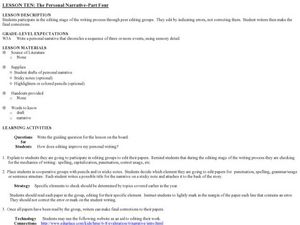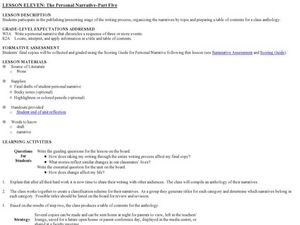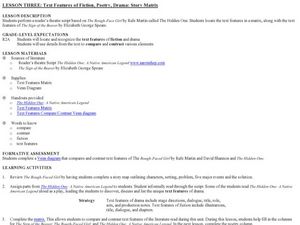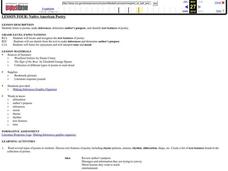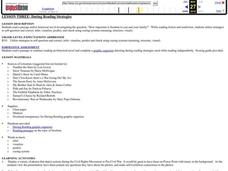Curated OER
Discovering New Units
Students use Cuisenaire rods to explore common denominators. In this fractions lesson, students build Cuisenaire representations of fractions, then find their equivalent counterparts to find the common denominator.
Curated OER
Summertime
Explore expressive reading through the read-aloud Summertime: From Porgy and Bess. Readers will make predictions about the text and listen to the song Summertime. They will also identify how the story relates to the song lyrics.
Utah Education Network (UEN)
Finding Missing Lengths of Similar Triangles
Middle and high schoolers explore the properties of similar triangles. In this geometry lesson, pupils play a similarity basketball game, sketch similar triangles, and find the missing measures of similar figures. They find the height of...
Curated OER
"Jack and Jill" Microsoft Word Picture ID Unit
Using Microsoft Word and the blank "Jack and Jill" templates provided, class members find picture files of themselves and create a written photo ID document to be printed and lamented for the classroom. The lesson is divided into 4...
Curated OER
Scale/Ratio
Investigate the use of ratios in scale drawings. Learners scale objects up or down using ratios then find the actual size of something using ratios. They apply their knowledge of ratios as they make their own telescopes in science...
Curated OER
Digging Deep for Figurative Language (Hyperbole)
What are hyperboles? Examine the attributes of hyperboles with your high school classes. Pupils read selected poems and prose selections that feature hyperboles and discuss their functions in each work of literature. Specific poems and...
Curated OER
What's Proper?
Learners practice using capital letters for proper nouns and adjectives. They play a matching game with word cards and correct paragraphs with incorrect capitalization, and edit their work with a partner.
Curated OER
Plagiarism
Don't get caught plagiarizing! Before starting your research unit, use this lesson to help your young writers identify plagiarism. The truth is, many kids don't even realize when they're doing it! They practice citing sources when...
Curated OER
Checking Sources For Accuracy
Middle schoolers will paraphrase a resource without plagiarizing. Then rewrite after reading text. They then evaluate the site or reference they are using for accuracy. In the end, they complete a note-taking organizer.
Curated OER
Analyzing Two or More Nonfiction Texts
How does recognizing the author's purpose help you draw conclusions about a topic? Using two articles (both are attached), learners brainstorm why each author wrote each article. Are their purposes similar or different? Learners use a...
Curated OER
The Personal Narrative - Part One
Read to write! The class lists sensory details based on the plot of a story they have recently read. They create a drawing of a bracelet and use the bracelet's jewels or charms to list sensory details included in the story. They then use...
Curated OER
The Personal Narrative - Part 3
Let's peer edit! Have your writers exchange their personal narratives with another learner! While peer editing, they will look for any missing information and identify strong details. They can practice literary analysis skills using a...
Curated OER
The Personal Narrative
After writing a personal narrative, learners edit their work and that of their classmates. Using the imbedded link, pupils edit their paper. They form small groups and check each other's papers for spelling, grammar usage, sentence...
Curated OER
The Personal Narrative - Part Five
Create a class anthology with your young writers. In this personal narrative lesson, each writer reflects on actions and events from their own lives and chronicles them in a three-part written sequence. They create a table of contents...
Curated OER
Researching the Past
Learners research the western movement in order to learn note taking strategies with nonfiction texts. They use the Internet to search for important information about the western movement using the Cornell Notes note-taking system. They...
Curated OER
Watch the Road Signs
What makes a good speaker? Upper elementary learners practice oral fluency by working with a partner to read nonfiction books. While reading, they practice using correct tone of voice, making eye contact, and speaking clearly.
Curated OER
On the Road Again
Young scholars read to their peers from selected texts. As one person reads, the other person listens to his/her peer, noting tone and fluency. Afterward, they reflect on each other's reading. There is a guided reflection worksheet...
Curated OER
Text Features of Fiction, Poetry, Drama: Story Matrix
How do novels differ from plays? Explore with your class the text features of fiction and drama by reading The Hidden One: Native American Legend and then performing a reader’s theater script based on the story. Class members create a...
Curated OER
Native American Poetry
Identify text features, make inferences, and discover the cultural significance of Native American Poetry. Sixth graders read several Native American poems and use graphic organizers and literature response logs to record their feelings...
Curated OER
Writing and Presenting a Fable Using Research
Elementary and middle schoolers research animal facts and use them in a fable. First, they pair-share to find animal traits to use in writing a fable. They then complete a prewriting worksheet. After going through the writing process,...
Curated OER
Identifying Text Features of a Self-Written Fable
Make learning the parts of a book fun by having pupils construct their own glossary entries, table of contents, and title page. Beginning with a review of text features and a hunt for examples, kids use previously written fables to...
Curated OER
During Reading Strategies
"How important is freedom to you and your family?" The guiding question becomes much more powerful after your class reads and responds to a passage from a historical novel. While reading the passage, they complete a graphic organizer...
Curated OER
Analyzing Messages in Various Media
Explore communication through media by analyzing different advertisements and artwork. Budding artists view videos, websites, plays, and other artistic endeavors while discussing the true meaning of the work with their classmates. They...
Curated OER
Sequencing
Are you looking for a way to teach sequence of events in your narrative writing unit? Bring this lesson to your middle school class, as it prompts young writers to create a narrative sequence map of events that have happened at school...












